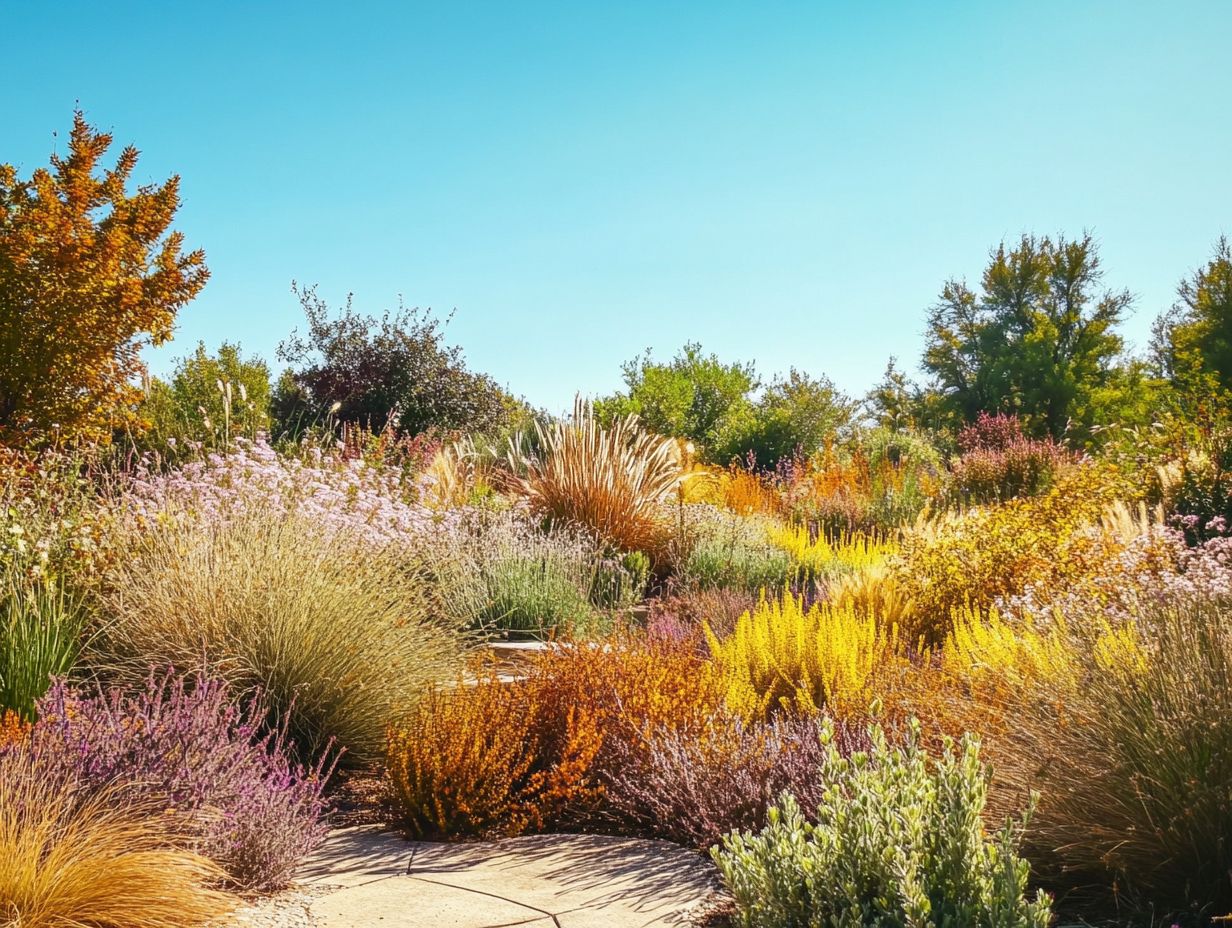Creating Windbreaks for Drought Gardens
Windbreaks play a crucial role in safeguarding your garden from harsh winds, especially in areas prone to drought. This guide delves into the various types of windbreaks available, covering both natural and man-made options.
You ll learn how to select the ideal location and materials tailored for your garden. Within this guide, you ll also discover a step-by-step approach to constructing your windbreak and maintenance tips to keep it functioning effectively.
Whether you re an experienced gardener or just starting your gardening journey, grasping the concept of windbreaks can significantly bolster your garden s resilience and overall success.
Contents
- Key Takeaways:
- Types of Windbreaks
- Conclusion
- Choosing the Right Location for a Windbreak
- Materials Needed for Building a Windbreak
- Step-by-Step Guide to Building a Windbreak
- Maintenance and Care of Windbreaks
- Frequently Asked Questions
- What are windbreaks and why are they important for drought gardens?
- What materials can be used for creating windbreaks for drought gardens?
- How should windbreaks be positioned in a drought garden?
- Can windbreaks also serve as decorative elements in a drought garden?
- How tall should windbreaks be for a drought garden?
- Are there any low-maintenance options for creating windbreaks in a drought garden?
Key Takeaways:

- Windbreaks are essential for protecting drought gardens from strong winds, which can cause water evaporation and damage to plants.
- There are two types of windbreaks: natural, like hedges and trees, and man-made, like fences and walls.
- When building a windbreak, consider wind direction, soil type, and available materials. Regular maintenance is crucial for maximum effectiveness.
Understanding the Importance of Windbreaks
Windbreaks are important natural features that offer benefits for both the environment and landowners. They mitigate soil erosion and create microclimates while supporting local wildlife habitats.
When you strategically plant trees and shrubs, you enhance biodiversity and reduce energy consumption by shielding your home from harsh weather. This thoughtful landscaping can even increase your property value.
Imagine stepping into a more comfortable outdoor space, where wind chill and noise pollution are reduced, making it inviting for both you and local wildlife. Understanding the significance of windbreaks is key to effective land stewardship.
These multifunctional barriers protect crops from relentless winds and help retain soil moisture, making them vital in arid regions. Incorporating native species like Eastern Red Cedar or Black Locust attracts beneficial insects and birds, promoting a healthy ecological balance.
An effective windbreak design combines tall trees on the outer layer with shorter shrubs closer to the field, maximizing wind reduction from multiple angles. This layered approach not only boosts biodiversity but also supports initiatives like creating a wildlife-friendly drought garden, leading to significant energy savings and minimizing heating costs in winter and cooling needs in summer.
The comprehensive advantages of implementing windbreaks in agricultural landscapes are simply remarkable. Are you ready to transform your garden?
Types of Windbreaks
Windbreaks can be elegantly classified into two primary categories: natural and man-made, each presenting distinct advantages tailored to various landscapes and objectives. Natural windbreaks, composed of native trees and shrubs, bolster biodiversity and create habitats for local wildlife.
Man-made windbreaks typically feature thoughtfully arranged species that enhance both shelter and visual appeal. Grasping these differences is essential for effective landscape design, as your choice between a natural or man-made approach should align with specific weather conditions, land use, and the benefits you seek to achieve.
Conclusion
In summary, windbreaks are essential for protecting gardens, enhancing biodiversity, and supporting local wildlife. For those looking to make their gardens more resilient, establishing a drought-tolerant garden can complement these efforts. Take action today to implement windbreaks in your garden and enjoy the numerous benefits they bring!
Natural vs. Man-made Windbreaks
Natural windbreaks, made of local trees and shrubs, enhance biodiversity and provide sustainable shelter for various wildlife. In contrast, man-made windbreaks are carefully made to meet specific agricultural or residential needs.
These two approaches come with unique benefits and challenges, particularly regarding their environmental impact and maintenance requirements. Natural windbreaks thrive in harmony with the local ecosystem and generally require less frequent upkeep. They serve multiple functions, including supporting native species, promoting soil health, and stabilizing microclimates. Researchers in southern Minnesota showed that natural windbreaks effectively reduce erosion and provide habitat for pollinators.
On the other hand, man-made windbreaks can be tailored for immediate effectiveness in shielding crops from harsh winds. A notable example from California illustrates how specifically engineered barriers improved vineyard yields, although they require ongoing maintenance to maintain their effectiveness.
Understanding these differences helps you choose the best windbreak for your land, aligning with your specific environmental conditions.
Choosing the Right Location for a Windbreak

When selecting the optimal location for a windbreak, carefully consider various factors, including prevailing wind patterns, topography, and existing vegetation. These elements significantly influence how effectively the structure will provide shelter and create microclimates.
A deep understanding of local weather conditions and their interaction with the landscape is essential for maximizing the benefits of windbreaks, whether for agricultural purposes or residential protection.
It s important to consider the design of the windbreak, including the density and spacing of trees and shrubs. This ensures adequate shelter while also promoting biodiversity.
Factors to Consider
When deciding on the perfect location for a windbreak, keep several key factors in mind. Consider the weather conditions, the desired height and length of the windbreak, and the spacing between trees and shrubs to ensure effective shelter.
Understanding local weather patterns is essential. If you live in an area that endures strong winter winds or frequent storms, you’ll want taller and denser windbreaks to effectively shield your crops and home. For instance, in regions facing harsh northwesterly gales, establishing a windbreak with dense evergreens can drastically reduce wind velocity, providing significant protection for sensitive crops. Additionally, consider creating a drought-resistant vegetable garden to enhance your gardening resilience.
During summer months, consider the orientation and layout of the windbreak to account for prevailing winds, offering optimal relief from hot, dry conditions. Proper tree placement is key; ideally, trees should be spaced to allow adequate airflow while still providing coverage. If you’re looking to enhance your garden, learn how to create a sustainable drought garden. Remember, tightly packed shrubs might create turbulence instead of smooth airflow, diminishing the windbreak’s effectiveness.
Materials Needed for Building a Windbreak
Creating a windbreak involves selecting materials thoughtfully, including the ideal species of trees and shrubs. To enhance your garden’s resilience, consider learning how to create a drought-resistant garden along with the essential tools for planting and maintenance. Each choice plays a significant role in ensuring the success and longevity of your structure.
By incorporating organic materials and compost, you enhance soil quality, supporting the thriving growth of the plants you ve chosen for your windbreak. Understanding the necessary materials not only helps you craft an effective windbreak but also fosters sustainability and ecological well-being.
Start planning your windbreak today!
Tools and Supplies
To build your windbreak, you need essential tools like shovels, trowels, gloves, and compost. These items make planting trees and shrubs easier and more successful.
A rake is also helpful for preparing the soil. Use high-quality mulch to keep moisture in and prevent weeds from competing with your young plants.
When choosing materials, go for organic and local resources. This choice benefits the ecosystem and supports sustainable practices.
Opt for native tree and shrub species to attract local wildlife and ensure your windbreak lasts. It will protect against harsh weather effectively.
Step-by-Step Guide to Building a Windbreak

Building a windbreak requires a careful plan that includes site preparation and selecting suitable trees and shrubs. Each step should focus on enhancing its role as a barrier that protects against wind, while also integrating wildlife habitats in drought gardens.
This guide provides clear instructions on how to build a windbreak that serves its purpose and blends into the landscape, encouraging biodiversity and sustainability.
Construction Process and Tips
The construction process of a windbreak involves several important steps: site preparation, planting trees and shrubs with appropriate spacing, and providing ongoing care to help them grow.
- Assessing your site is essential. Examine the soil type, drainage, and sunlight exposure, as these factors will influence your choice of species.
- Proper site preparation is key. Clear away any debris, grade the area, and consider amending the soil to improve its fertility.
- Once the space is ready, focus on planting techniques that ensure optimal spacing. This will help reduce competition for resources while maximizing wind protection.
After planting, maintaining your windbreak is crucial. Make regular watering part of your routine, especially during dry spells, and apply organic mulch to support healthy root development.
Maintenance and Care of Windbreaks
Keeping your windbreak effective requires regular monitoring and watering. Enrich the soil with organic matter to promote strong growth.
This diligent care supports the structural integrity of your windbreak and nurtures the ecosystem it harbors, providing lasting benefits for wildlife and preventing soil erosion.
By understanding the maintenance needs of your windbreak, you ll create a thriving and functional shelter that benefits both you and the environment.
Keeping Windbreaks Effective and Healthy
To maintain the health of your windbreaks, ongoing maintenance is essential. Monitor plant health and manage pests to ensure a balanced ecosystem that supports wildlife habitats.
Regular assessments help you identify early signs of plant stress or disease, allowing for prompt action. Integrate a variety of native species to enhance the resilience of your windbreaks and attract beneficial insects that assist with pest control.
Use sustainable pest management practices, such as introducing natural predators or using organic deterrents, to reduce reliance on chemical treatments. Fostering a diverse ecosystem enhances the overall functionality of your windbreaks, ensuring they remain effective against wind and erosion while supporting local wildlife.
Frequently Asked Questions

What are windbreaks and why are they important for drought gardens?
Windbreaks are barriers that protect plants from strong winds. They help conserve moisture and improve plant growth by reducing wind speed and preventing dehydration. Additionally, you can learn how to design a drought-tolerant garden to further enhance your landscaping efforts.
What materials can be used for creating windbreaks for drought gardens?
Various materials can be used for windbreaks, including:
- Wooden boards
- Mesh fencing
- Hedges
- Large rocks
The choice of material depends on factors like cost, durability, and effectiveness.
How should windbreaks be positioned in a drought garden?
Position windbreaks at a right angle to the main wind direction to effectively block the wind from reaching the garden. Leave enough space between the windbreak and the garden to ensure sunlight reaches the plants.
Can windbreaks also serve as decorative elements in a drought garden?
Windbreaks not only protect your plants but also bring beauty to your garden! Hedges can be shaped into various designs, enhancing the visual appeal of the space.
How tall should windbreaks be for a drought garden?
The height of windbreaks depends on the type of plants needing protection and the strength of the winds. They should generally be at least 50% taller than the plants they protect to be effective.
Are there any low-maintenance options for creating windbreaks in a drought garden?
Yes! Consider planting native trees or shrubs adapted to the local climate. These plants require less water and maintenance, making them ideal for a drought garden.
Start planning your drought garden today and see the difference windbreaks can make!






